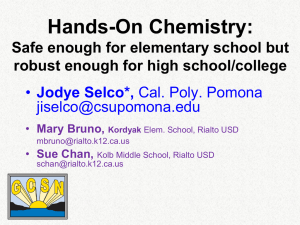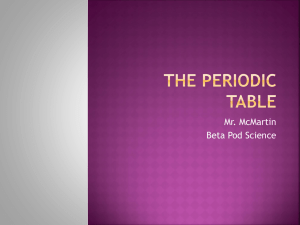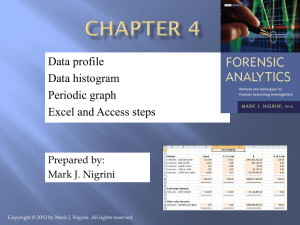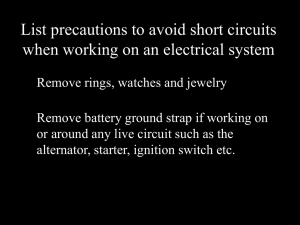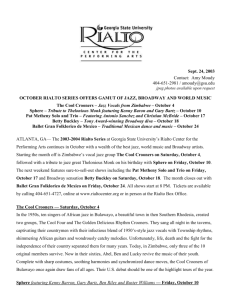Hands on, Minds on Periodic Table: Visualizing the Unseen
advertisement
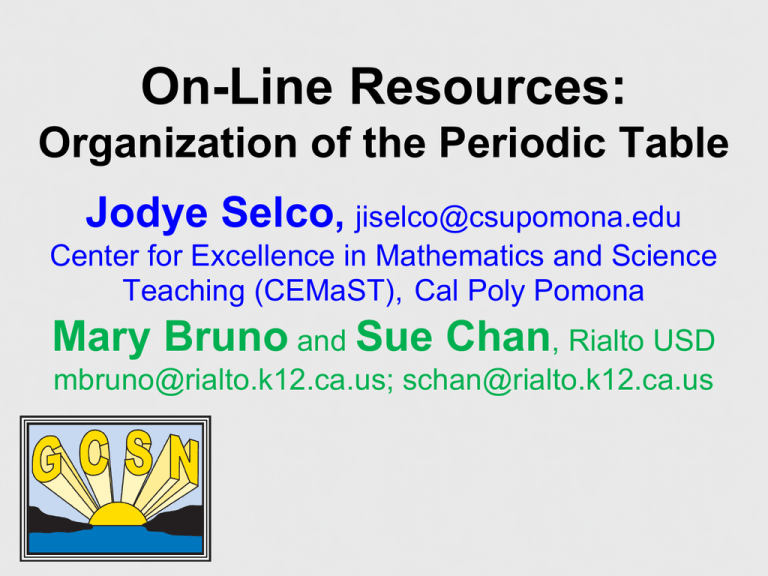
On-Line Resources: Organization of the Periodic Table Jodye Selco, jiselco@csupomona.edu Center for Excellence in Mathematics and Science Teaching (CEMaST), Cal Poly Pomona Mary Bruno and Sue Chan, Rialto USD mbruno@rialto.k12.ca.us; schan@rialto.k12.ca.us NGSS: • 5-PS1 Matter and Its Interactions (1); Practices (using models, math thinking); Crosscutting (cause and effect) • MS-PS1 Matter and its Interactions (1, 5); Practices (use models, construct explanations and design solutions, obtain, science models and laws); Crosscutting (patterns, proportion) • HS-PS1 Use periodic table, periodic trends, math representations, models of nuclei; Practices (use models, use mathematical thinking); Crosscutting (patterns) Goal: Devise a way to teach how the Periodic Table is organized so all students, regardless of grade, can understand how to “read” the Periodic Table and to connect this information to the chemical properties of elements. Website • http://www.csupomona.edu/ ~jiselco/periodictable/ • http://www.csupomona.edu/ ~jiselco/periodictable/ New Virtual Simulation Summary • This method is helping learners of all ages understand how the Periodic Table is organized 1. Valence electrons are responsible for the chemistry 2. Chemical properties of elements in a column have similar chemical behavior 3. Atoms in a column have the same number of valence electrons 4. Atomic size increases down a column 5. Atomic size decreases to the right of a row 6. The Periodic Table is a great graphic organizer Interested in learning more? • Full lesson for use with physical manipulatives for elementary, middle and high school/college • Files available to print Periodic Table skeletons http://www.csupomona.edu/~cemast/ LessonPlan&Links.shtml Jodye Selco jiselco@csupomona.edu Mary Bruno mbruno@rialto.k12.ca.us Sue Chan schan@rialto.k12.ca.us Acknowledgements: • Mary Bruno and Sue Chan • Rialto Unified School District 5th grade teachers and students • CaMSP (California Mathematics and Science Partnership) grant • Dr. Ed D’Souza for having the wisdom to make us a teaching team Using these atomic models, you can teach (science): • Combining ratios in binary compounds • How to write chemical formulae • Conservation of matter during a reaction and balancing equations • Why elements in a family have similar chemical behavior • Predicting combining ratios for main group atoms Results (6 years later): • Students (even elementary students!) can learn to “read” the periodic table as evidenced by their ability to correctly predict combining ratios in binary compounds • Student scores on CST (especially physical science/chemistry) and district benchmark exams has been increasing year by year (including special needs students). th 5 Grade Science CST Scores 2004 2005 2006 2007 2008 2009 2010 2011 100% 80% Basic 60% Below Basic 40% 20% 0% Far Below Basic 0% 20% Proficient 40% 60% Advanced Factor of 4.4 increase in number of students that are proficient and advanced from 2004 to 2011. Chemistry professional development provided to teachers in 2005. 8th Grade Physical Science CST Scores 2006 2007 2008 2009 2010 2011 80 60 Basic 40 Below Basic 20 0 Far Below Basic 0 20 Proficient 40 Advanced Factor of ~3 increase in number of students that are proficient and advanced from 2006 to 2011. First 5th grade cohort in 8th grade 2007-2008. 60 High School Chemistry CST Scores 2006 2007 2008 2009 2010 2011 80 60 Basic 40 Below Basic 20 0 Far Below Basic 0 20 Proficient 40 Advanced Factor of ~2.7 increase in number of students that are proficient and advanced from 2006 to 2011. First 5th grade cohort in HS grade 2010 and 2011. 60 Rules for Making Binary Compounds • Use only two differently colored (or two types of) atoms to connect the unpaired electrons to other atoms use as many as you need borrowing from other groups as necessary. • You are all done when all unpaired electrons have a single partner and none are left unpaired. Your Turn to Make Molecules! • Use only two differently colored (or two types of) atoms to connect the unpaired electrons to other atoms use as many as you need borrowing from other groups as necessary. • You are all done when all unpaired electrons have a single partner and none are left unpaired. Binary Compounds Writing Chemical Formulae • 4 purple, 1 pink 4 P, 1 Pi P4Pi • This demystifies why some elements have a second letter in their symbol • What a chemical formula means • Why 2 units of P4Pi is not equal to P8Pi2 and should be written 2 P4Pi

